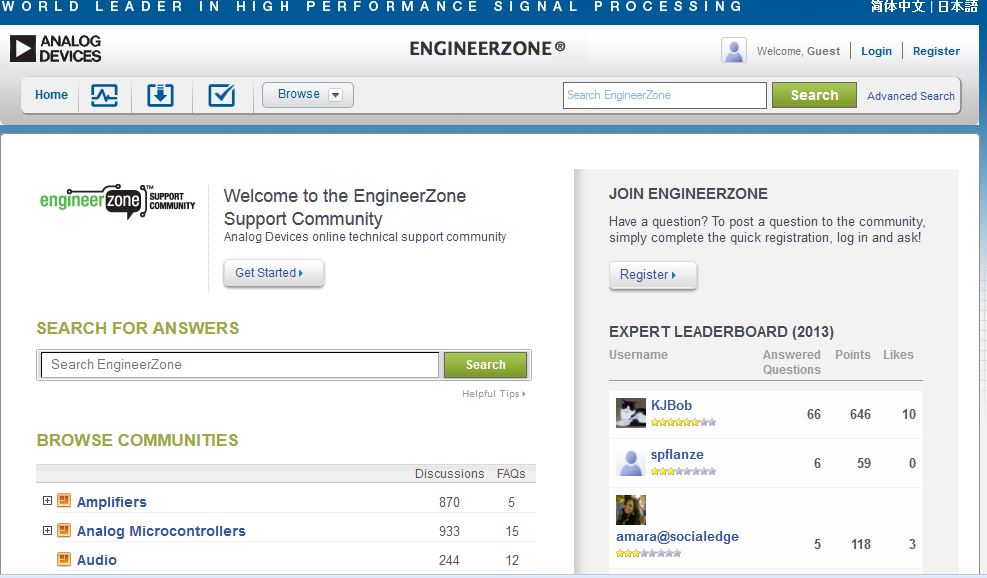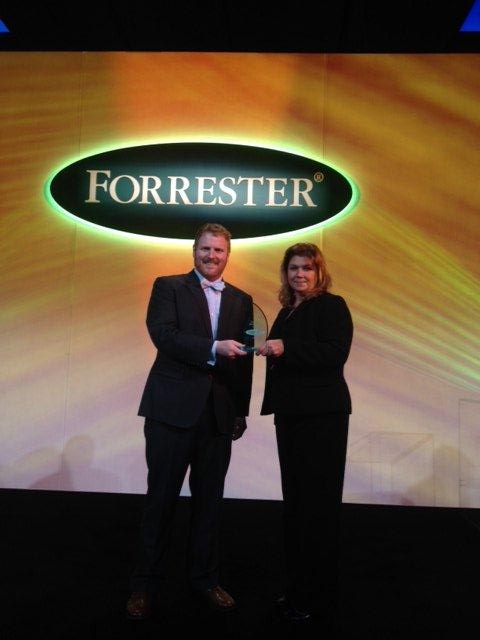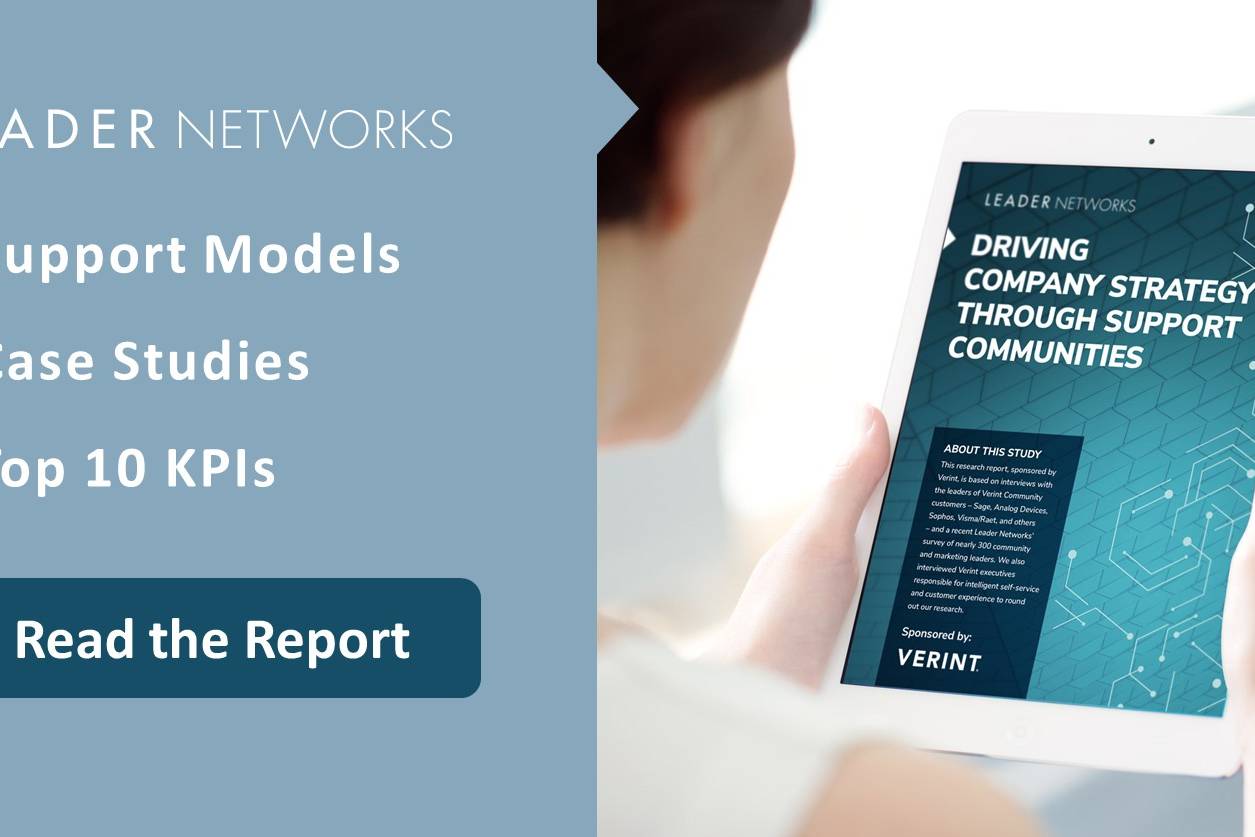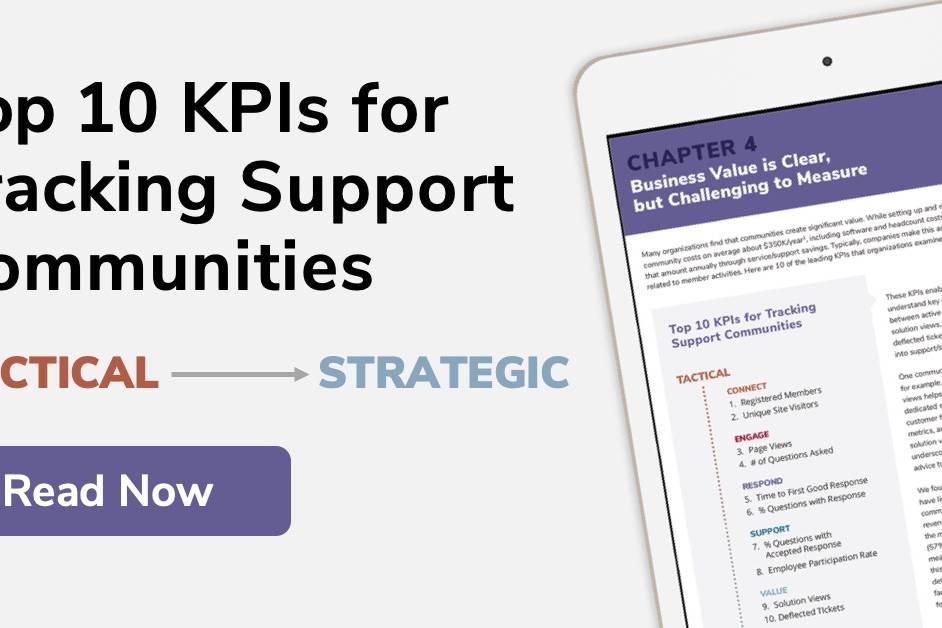What happens behind the scenes of major B2B online communities? How do traditional businesses like manufacturing use online community to advance? As part of our ongoing series of interviews with outstanding B2B online community leadership, we spoke with Jennifer Mitchell, the Lead, Community & Social Business Center of Excellence at Analog Devices, Inc.
Analog Devices, Inc., (ADI: NASDQ), is an American, multinational semiconductor company specializing in data conversion and signal conditioning technology, headquartered in Norwood, Massachusetts. Their revenues top $2.6B.
Just last week, EngineerZone won not one but two premier awards for B2B online community. EngineerZone was awarded the winning entry for the 2013 Forrester Groundswell Award in the category of Social Relationship, Business to Business AND The Society of New Communications Research (SNCR) 2013 Commendation of Excellence in the Online Community Category Corporate Division.
Jennifer Mitchell has been leading Analog Devices online strategy and initiative for over 15 years. She has been a pioneer at Analog – first helping initiate e-payment systems, shepherding them into the digital marketing realm, and dedicated to the strategy and operations of social business for Analog Devices. She is dedicated to supporting the needs of Analog’s engineering customers around the world.
Now, let’s hear from Jennifer Mitchell about Engineer Zone:
Vanessa DiMauro: Can you please share a little about Analog Devices and your online community Engineer Zone.
Jennifer Mitchell: Analog Devices is a leading manufacturer of analog, mixed-signal and digital signal processing integrated circuits used in end products across various applications. Our online community, EngineerZone is focused on providing online technical support. It was launched in 2009 and we currently have over 16,000 members. The community mission is to provide customers (design engineers) with direct access to ADI Engineers who can answer complex design questions about our products so they can get their product to market faster.
VD: The EngineerZone community encompasses a wide scope of Analog and digital products under a single community umbrella. How do you manage scale?
JM: Scale is managed through ownership. Every community that is launched is required to have a community manager assigned to it at all times. The role of the community manager is not necessarily to answer questions, but to assure that questions are answered on a timely basis (according to our SLA of 2 business days at most) and that they are well-moderated. Consistency of voice and brand is achieved via social media training that we require for all team members prior to launching a community.
VD: Community moderation is important factor for online community success. What is your CM staffing model and what role does moderation/facilitation take with EngineerZone?
JM: We have 1-5 community managers for each community and sub-communities. These Community Managers reside within our product lines, are usually application engineers but could be product marketing managers. They agreed to take on the role of CM prior to launch and assure that the community has continuous community manager ownership. About 10 – 30% of an FTE is needed to support this activity, depending on the nature and size of the community.
We take measuring the SLA (service level agreement) of each community very seriously, and measure it quarterly; however some product lines are tracking it more frequently (monthly). . We have various strategies for assuring communities are well-moderated, from email alerts for specific sub groups to keyword alerts to team members. We even have one community manager who has tied responsiveness to community questions to the team’s performance reviews and goals, which underscores the importance of a well-moderated community. By plotting the response time of individual communities against the other communities, community managers have been able to make significant improvements in responding to customers.
VD: Who is responsible for content creation and other editorial efforts like the content calendar and working with subject matter experts (SMEs)?
JM: Given EngineerZone is a technical support community, the content is driven by the needs of the customers who use it for answers to their design and product questions. We do however, offer a system blog, and many of the community teams have taken advantage of this to communicate new releases and updates to customers. We also use the blog for groups to post product updates, thought leadership topics and general communications.
VD: Operational impact becoming increasing essential to online community value – to both members and the sponsoring company. Does what happens in the community get leveraged to impact core operations such as product development or R&D?
JM: We have begun to better leverage the insights shared in the discussions in the community via social listening tools to feed overarching themes back to the product lines. Out technical documentation team regularly search the community for input on datasheets. We would like to formalize this process further. We have also launched and supported several private and secret groups with specific customer types, so we can use the community to collaborate on new products currently under NDA (non-disclosure agreements).
The business goals are led collaboratively between the Lead for Social Business & Community, the Enterprise Community Manager and the individual community managers across the company supporting spaces.
VD: How do you excite your executives about community – what are some of the key “hooks”?
JM: We have over 60,000 core market customers who, generally speaking, do not have direct sales support, and therefore depend on our web presence to “self-serve”, we have found that the community is a valuable resource to them and a key differentiator. Through brand studies and customers discussions, we have learned that our internal engineers are considered the best in the field, and the ADI brand is strongly tied to innovation. This direct link to our engineering community is powerful. As the conversations continue and more content is added, we have developed a rich knowledge base for customers to tap into.
We’ve learned through recent membership surveys that 50-60% of the time, members are finding answers to their questions just by searching the community. We also have learned the 78% of members find the content valuable to extremely valuable, which is up 8% from the previous year. The support we provide to core market customers has broader reach and scalability, helping them get their products to market faster.
VD: What are some of the most important ROI metrics for your organization?
JM: We currently measure not only membership and page views, but also customer engagement. We are not looking to simply grow membership, but want to assure the community brings value to customers through their continuous engagement in both searching and posting, as well as helping other customers and user-generated content. We will be looking for ways that we can tie increased customer engagement back to future sales, as well as sampling for products and evaluation board purchases.
VD: What is one thing about your community that you / your organization is most proud of?
JM: I am most proud of the transformation and buy-in we received from the engineering community to support this initiative. The onboarding process took over 2 years, lots of training and lots of convincing. We exposed product line people who were previously protected from front line support, directly in front of customers and even students. They have taken ownership of the communities and see the value and scalability of the many-to-many model. In fact, one engineering manager recently added to the goals of his reports a benchmark goal for response times, underscoring the importance of a well-moderated forum. They have seen significant improvements in meetings the benchmark goal, which is tied directly to engagement in the community.
Warning: Attempt to read property "base" on array in /home3/trusten9/public_html/leadernetworks/wp-content/plugins/wp-user-profile-avatar/shortcodes/wp-user-profile-avatar-shortcodes.php on line 665
Warning: Attempt to read property "base" on array in /home3/trusten9/public_html/leadernetworks/wp-content/plugins/wp-user-profile-avatar/shortcodes/wp-user-profile-avatar-shortcodes.php on line 665
Warning: Attempt to read property "base" on array in /home3/trusten9/public_html/leadernetworks/wp-content/plugins/wp-user-profile-avatar/shortcodes/wp-user-profile-avatar-shortcodes.php on line 665
Warning: Attempt to read property "base" on array in /home3/trusten9/public_html/leadernetworks/wp-content/plugins/wp-user-profile-avatar/shortcodes/wp-user-profile-avatar-shortcodes.php on line 665
Vanessa DiMauro
Internationally recognized independent thought leader on social business strategy and operations with a specialty in online community. I help organizations drive top line growth through innovative digital strategy design and thoughtful execution. I have successfully led 60+ strategic social business initiatives for the world's most influential organizations over my 20 years as a social business executive and serve on a number of boards. My award-winning track-record is fueled by passion, experience and research.
My work has been covered by leading publications such as the New York Times, the Wall Street Journal and CIO Magazine and was recently named a Social Marketing Master by Forbes. As a former Executive in Residence at Babson College, Olin School of Management, I am an engaging and informational educator and keynote speaker.
1 Comment
Add comment Cancel reply
This site uses Akismet to reduce spam. Learn how your comment data is processed.





[…] See original article at leadernetworks.com […]